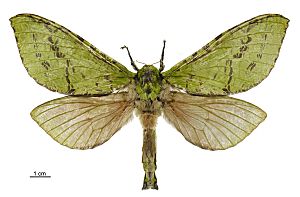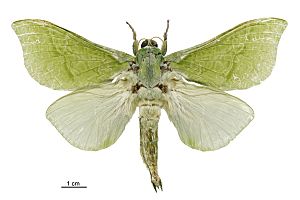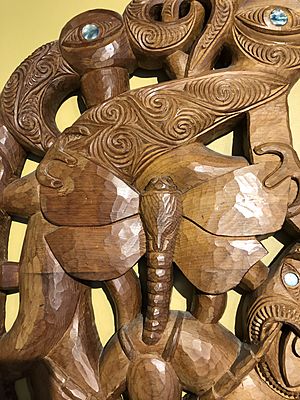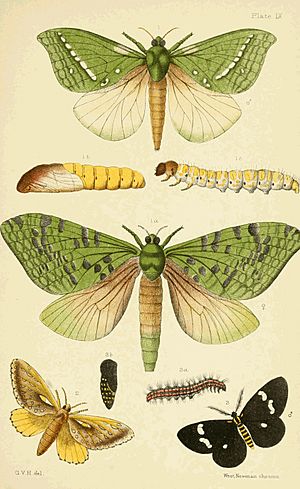Puriri moth facts for kids
Quick facts for kids Puriri moth |
|
|---|---|
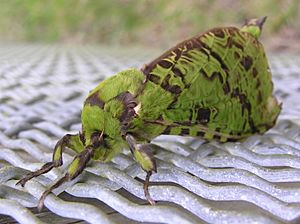 |
|
| Scientific classification | |
| Genus: |
Aenetus
|
| Species: |
virescens
|
| Synonyms | |
|
|
The puriri moth (Aenetus virescens) is also known as the ghost moth or pepetuna. It's a type of moth from the family called Hepialidae. This amazing moth lives only in the North Island of New Zealand. It's New Zealand's biggest moth, with wings that can spread up to 150 mm wide! The puriri moth spends most of its life, about five to six years, as a grub living inside a tree trunk. Then, it transforms into a moth and lives for only about 48 hours.
Contents
Discovering the Puriri Moth
This moth was first described in 1843 by a scientist named Edward Doubleday. He wrote about it in a book called Travels in New Zealand. Doubleday first called the moth Hepialis uirescens. Later, George Hudson also wrote about and drew this moth in his book, The Butterflies and Moths of New Zealand. People also commonly call this moth the ghost moth or pepetuna.
What Does a Puriri Moth Look Like?
You can easily spot a puriri moth because of its large size and bright colors. Male and female moths look a bit different. The male moths usually have a wingspan of about 100mm. Female moths are larger, with wings that can spread up to 150mm. This makes it New Zealand's biggest native flying insect!
The front wings of the moth are usually bright green. Females often have brownish-black patterns, while males have white patterns. The back wings are a pretty pink color. Sometimes, you might see puriri moths with different colors, like blue-green, bright yellow, brick-red, or even all white.
These moths are active at night and live in forests. In the past, male moths would often fly towards lights in towns. But now, with fewer forests, this happens less often.
Puriri Moth Predators
Birds like kaka and moreporks sometimes eat adult puriri moths. They often catch the moths when they gather around lights. Native bats, cats, and brushtail possums also hunt them. Long ago, Māori people would traditionally eat the caterpillars, which they called ngutara. They would use water to get the caterpillars out of their tunnels in the trees.
The Puriri Moth Life Cycle
The caterpillar stage of the puriri moth can last for a very long time, up to six years! The adult moths usually come out between September and November. Adult moths only live for a few days at most. They are most active during dusk and at night when they mate and lay eggs. Adult moths don't have mouths to eat. They live off the food they stored as caterpillars.
Female moths can lay around 2000 eggs in their short adult life. They drop these eggs randomly on the forest floor. The eggs start as yellow-white and turn black before they hatch. This usually happens after about two weeks.
When they first hatch, the tiny caterpillars live under rotting wood near the ground. They eat a type of fungus found there. After about a year, the caterpillars move into a host tree. They build a special tunnel inside the tree's trunk or branches. This tunnel is often shaped like the number seven. It goes into the tree about 40-50mm and then turns downwards for about 150mm. The caterpillar makes the tunnel bigger as it grows. It also covers the entrance with a web made of silk and wood chips to hide and protect itself.
At night, the caterpillar comes out to eat the soft tissue around the tunnel's entrance. It stays hidden under its camouflaged web, which often looks just like the tree bark. The caterpillar grows to about 100mm long before it changes into a pupa. The pupa stage lasts for four to five months. Then, the pupa wiggles up the tunnel and pushes through the web. It splits its skin and the adult moth emerges! The moth then lives for about 48 hours.
Host Plants for Puriri Moths
The puriri moth gets its name from the puriri tree (Vitex lucens), which is a common tree it lives in. However, it also lives in many other native and non-native forest trees. Another common host plant is the putaputawētā (Carpodetus serratus). This tree is named after the wētā insects that often hide in the old holes left by puriri moth caterpillars.
Puriri moth caterpillars also live in native trees like beech, titoki, kanuka, maire, manuka, wineberry, and houhere. They can also be found in trees that were brought to New Zealand, such as eucalyptus, English oak, silver birch, lemon, apple, and willow.
Here are some of the plants that puriri moths use as hosts:
- Smoky bracket
- Alectryon excelsus, tītoki
- Aristotelia serrata, wineberry
- Buddleja davidii, Buddleia
- Carpodetus serratus, marbleleaf


